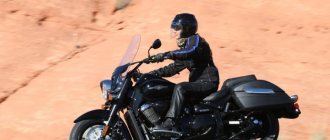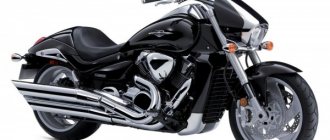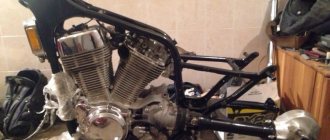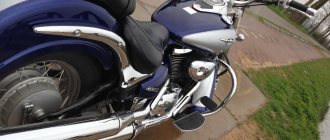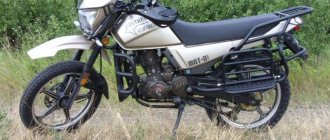| Suzuki Boulevard M50/Intruder M800 (2005-2009) | Suzuki Boulevard M50/Intruder M800 (2010-2019) |
Suzuki Intruder M800 cruiser model
appeared in early 2005 as a replacement for the Suzuki VZ800 Marauder (Desperado).
In the North American market, the model was sold under the name Suzuki Boulevard M50
.
Despite the difference in names, both motorcycles are almost completely identical (with the exception of logos and nameplates). At the same time, a domestic Japanese version was also introduced, called the Suzuki Boulevard 400, which shared visual features with the Intruder M800 / Boulevard M50, but with a number of technical differences. However, the export version of the Suzuki Intruder M800 (Boulevard M50) from 2005 to 2006. It was also sold in a limited edition in Japan under the name Suzuki Boulevard 800
(outwardly identical to the M50, but without the M50 stickers on the plastic side covers).
The Suzuki Intruder M800 (Boulevard M50) model was built on the basis of the classic version of the Suzuki VL800 Intruder (Boulevard C50), differing from it not only externally (fenders, wheels, front suspension, headlight, etc.), but also in engine - in particular, chopped connecting rods and other valves (which also required minor changes to the cylinder head). The engine of the Suzuki Intruder M800 (Boulevard M50) is a 2-cylinder V-shaped liquid-cooled unit with a volume of 805 cc. see, producing 52 hp. power and 68 Nm of torque. Maximum engine performance is at 4000-6000 rpm.
In 2009, the model receives minor changes regarding the shape of the air filter housing (triangle shape) and the instrument panel (an LCD fuel level indicator appears). The intake system gets dual throttle valves (SDTV system).
In 2010, the model underwent a major restyling, receiving the visual features of the older version of the Suzuki Intruder M1500 (Boulevard M90) and the same engine from the C50 version (this simplified the search for spare parts, making the M50 and C50 engines completely unified with each other).
2019 was the final year of production of the Suzuki Boulevard M50.
The main competitors of the Suzuki Intruder M800 (Boulevard M50) in the class:
- Honda Shadow 750
- Kawasaki VN900 Vulcan
- Yamaha Midnight Star 950
Brief history of the model
- 2005 - start of production and sales of Suzuki Intruder M800 (Boulevard M50).
Model:
Suzuki Intruder M800 / Boulevard M50 (Europe, Oceania, North America).
Factory designation:
VZ800K5.
- 2006 - no significant changes.
Model:
Suzuki Intruder M800 / Boulevard M50 (Europe, Oceania, North America).
Factory designation:
VZ800K6.
- 2007 - no significant changes.
Model:
Suzuki Intruder M800 / Boulevard M50 (Europe, Oceania, North America).
Factory designation:
VZ800K7.
- 2008 - no significant changes.
Model:
Suzuki Intruder M800 / Boulevard M50 (Europe, Oceania, North America).
Factory designation:
VZ800K8.
- 2009 - slight restyling of the model. New instrument panel with fuel level indicator and triangular air filter housing. The simple injector is replaced by a dual throttle body system (SDTV system).
Model:
Suzuki Intruder M800 / Boulevard M50 (Europe, Oceania, North America).
Factory designation:
VZ800K9.
- 2010 - restyling of the model. The bike gets a new look and engine from the C50.
Model:
Suzuki Intruder M800 / Boulevard M50 (Europe, Oceania, North America).
Factory designation:
VZ800L0.
- 2011 - no significant changes.
Model:
Suzuki Intruder M800 / Boulevard M50 (Europe, Oceania, North America).
Factory designation:
VZ800L1.
- 2012 - no significant changes.
Model:
Suzuki Intruder M800 / Boulevard M50 (Europe, Oceania, North America).
Factory designation:
VZ800L2.
- 2013 - no significant changes.
Model:
Suzuki Intruder M800 / Boulevard M50 (Europe, Oceania, North America).
Factory designation:
VZ800L3.
- 2014 - no significant changes.
Model:
Suzuki Intruder M800 / Boulevard M50 (Europe, Oceania, North America).
Factory designation:
VZ800L4.
- 2015 - Model available in North America only.
Model:
Suzuki Intruder M800 / Boulevard M50 (Europe, North America).
Factory designation:
VZ800L5.
- 2016 - no significant changes.
Model:
Suzuki Intruder M800 / Boulevard M50 (Europe, North America).
Factory designation:
VZ800L6.
- 2017 - no significant changes.
Model:
Suzuki Boulevard M50 (North America).
Factory designation:
VZ800L7.
- 2018 - no significant changes.
Model:
Suzuki Boulevard M50 (North America).
Factory designation:
VZ800L8.
- 2019 is the last year of production.
Model:
Suzuki Boulevard M50 (North America).
Factory designation:
VZ800L9.
Photos
| Suzuki Boulevard M50/Intruder M800 (2005-2008) | Suzuki Boulevard M50/Intruder M800 (2009) | Suzuki Boulevard M50/Intruder M800 (2005-2008) |
| Suzuki Boulevard M50/Intruder M800 (2009) | Suzuki Boulevard M50/Intruder M800 (2010-2019) | Suzuki Boulevard M50/Intruder M800 (2010-2019) |
| Suzuki Boulevard M50/Intruder M800 (2010-2019) | Suzuki Boulevard M50/Intruder M800 (2010-2019) |
Specifications
Technical characteristics of Suzuki Intruder M800 (Boulevard M50):
| Model | Suzuki Intruder M800 (Boulevard M50) |
| Motorcycle type | cruiser |
| Year of issue | 2005+ |
| Frame | steel tubular |
| engine's type | 2-cylinder, 4-stroke, V-shaped |
| Working volume | 805 cm³ |
| Bore/Stroke | 83.0 x 74.4 mm |
| Compression ratio | 9,4:1 |
| Cooling | liquid |
| Number of valves per cylinder | SOHC, 4 valves per cylinder |
| Fuel supply system | injector, 2x 34 mm — Intruder M800 (Boulevard M50), 2005-2008 injector (SDTV — Suzuki Dual Throttle Valve), 2x 34 mm — Intruder M800 (Boulevard M50), 2009+ |
| Ignition type | transistor |
| Maximum power | 52.0 hp (38.0 kW) at 6000 rpm |
| Maximum torque | 68 Nm (6.9 kg*m) at 4000 rpm |
| Clutch | Multi-disc in oil bath, cable drive |
| Transmission | 5-speed |
| type of drive | cardan |
| Front tire size | 130/90-16M/C 67H |
| Rear tire size | 170/80-15M/C 77H |
| Front brakes | 1 disc, 300 mm, 2-piston caliper |
| Rear brakes | drum |
| Front suspension | inverted fork, travel - 140 mm |
| Rear suspension | pendulum with monoshock absorber (adjustable preload), stroke - 105 mm |
| Overall dimensions (length x width x height) | 2370 x 920 x 1125 mm - Boulevard M50 / Intruder M800 (2005-2009) 2395 x 890 x 1105 mm - Boulevard M50 / Intruder M800 (2010+) |
| Wheelbase | 1655 mm |
| Seat height | 700 mm |
| Minimum ground clearance | 140 mm |
| Gas tank capacity | 15.5 l (including reserve - 3.0 l) - all models, except versions for California 15.0 l (including reserve - 3.0 l) - versions for California |
| Maximum speed | 172 km/h[1] |
| Acceleration to 100 km/h | 5.39 sec[2] |
| Motorcycle weight | 247 kg - dry 269 kg - loaded |
Suzuki Boulevard M50: comparative test drive with Kawasaki VN900 Custom
Why do they love choppers? For external beauty, a certain charisma of style, pathos... Everyone finds something of their own in them. The buyer of such motorcycles is of little interest in their technical characteristics. Well, perhaps the displacement of the engine. And, although the main attention is often paid to appearance, there is a certain level (and it is both moral and technical) for the “sufficiency” of engine volume. And in our case, both test participants correspond to it. At the same time, they are both technically close and, at the same time, quite different from each other, and, as it turned out, not only externally. Their “intra-class” differences clearly place them in opposite corners of the ring. Oh, I'm sorry – I meant to say “market”!
On American versions of motorcycles, the first thing that irritates us is the speedometer marking in miles per hour. Of course, there are markings in kilometers per hour, but they are very difficult to discern.
One of the positive features of the Suzuki is rear wheel drive via a cardan shaft. For our conditions, this is still better and more reliable than a belt.
Suzuki Boulevard M50 (European name - Suzuki Intruder M800 Suzuki family of power cruisers . Of course, compared to the flagship of the line, the Suzuki Boulevard M109R ( Suzuki Intruder M1800R ), its engine capacity is not at all impressive, and its design is more similar to classic cruisers. But pay attention to the details: an inverted telescopic fork, a liquid cooling radiator hidden between the front frame pipes, a miniature front and wide rear fenders - very radical solutions for pure “classics”. And only one detail allows us to doubt its complete professional suitability for the subclass of power cruisers - the absence of a second brake disc at the front. If we are to position the motorcycle as a power cruiser, then be so kind as to take care not only of the appearance and engine, but also of proper brakes. After all, as practice shows, he really doesn’t have enough of them. However, the engineers did not bother to eliminate this drawback even in the new 2010 model, whose design is already more reminiscent of the “sports” Suzuki Boulevard M109R and Suzuki Boulevard M90 .
Kawasaki Vulcan VN900 Custom is a representative of a different trend of custom bikes that is popular nowadays. The main thing in it is not functionality, but His Majesty style! Perhaps that is why the designers of the model limited themselves to a “one and a half” seat, on which the passenger will be uncomfortable (although if she is a petite girl, then she will get from the cafe to the beach quite comfortably on it). But visually it unloads the rear of the motorcycle. The front part of the bike is decorated with a 21-inch cast light alloy wheel with a sophisticated spoke pattern and a typical narrow tire. In the 2009 Ebony Special Edition that we tested, the designers also focused on the engine. Its cylinder covers are painted matte orange. The presence of chrome is kept to a minimum - instead, black and muted bronze colors rule the roost. Even the muffler pipes are painted matte black.
I've previously ridden Vulcans with pseudo-hardtail rear suspension similar to the one on the test bike. And, I remember, the sensations were the most “hard” ever. That is, if the presence of the rear suspension was felt, it was only slightly. That’s why, looking at the Kawasaki Vulcan VN900 Custom before the test, I was mentally prepared for the fact that my butt would have a hard time. I wanted to loosen the rear monoshock as much as possible, but it turned out to be not located very well, and it would have taken a lot of time to get to the adjusting ring. So I decided not to bother and left the spring preload adjustment in the middle position, limiting myself to only adjusting the pressure in the rear cylinder, lowering it to 2.2 atmospheres. As it turned out, this was enough to feel comfortable in the Vulcan seat when driving alone. Due to the lack of a full-fledged passenger seat, I did not risk the photographer with his expensive equipment and use him as a passenger.
I didn’t want Kawasaki Vulcan VN900 with anyone Situated behind the Suzuki Boulevard M50 , I slowly overcame the urban jungle, and was forced to admit that the motorcycle felt quite comfortable in it. The small width of the steering wheel and low center of gravity make it easy to squeeze between the rows of cars piled up at a traffic light, and decent acceleration dynamics allow you to be the first to go green from the start.
Thoughts about the rigidity of the rear suspension disappeared after a couple of kilometers. On this motorcycle, the “pseudo-hardtail” only looks intimidating, but in fact it copes with its direct responsibilities very well. In addition, unlike the passenger seat, the driver’s seat turned out to be quite soft and comfortable, and most importantly, well profiled. Therefore, if the suspension did not have time to handle any irregularities, after it there was another “filter” that softened the blows.
Before the test, I had another concern. Looking at the large but narrow front wheel and wide rear wheel, it looked like the bike would handle like your average chopper. That is, in order to enter a turn, you will have to “ask” it well... But here, too, a miracle happened - this “900” turned out to be surprisingly maneuverable at almost any speed. Apparently, the correct calculation of the angle of inclination and the amount of fork offset played a role. Even when driving at walking speeds, this heavy chopper showed no desire to fall on its side. But in the Suzuki Boulevard M50 this effect was present and was especially noticeable when driving with a passenger.
Compared to the large 21-inch front wheel, even a three-hundred-millimeter brake disc looks small and does not inspire confidence. Considering that it works in tandem with a budget two-piston caliper, you can’t expect high power from it. In practice, everything turns out to be the same as in theory. For effective braking, using one front brake is clearly not enough. Additional assistance is required in the form of a rear disc brake. And it’s nice that this help radically changes the situation, completely satisfying the pilot’s requests regarding the deceleration rate. In the case of the Kawasaki Vulcan, the rear brake is a full-fledged functional part of the motorcycle, which is simply necessary to use. And, as it seemed to me, despite the fact that in most motorcycles the main brake is considered to be the front one, in this bike the main one is still the rear one.
If you change from a Kawasaki Vulcan to a Suzuki Boulevard, the first thing you lose is the feeling of riding a luxury motorcycle that literally attracts the attention of passers-by. Boulevard M50 looks very simple compared to its competitor. Although, if we were comparing the M50 with the regular version of the Kawasaki Vulcan VN900 , and not the limited Custom, the difference in the perception of the external appearance of the motorcycles would not be so great.
The second point is sound. Whatever you say, Kawasaki is richer and bassier, and therefore evokes more emotions than the ordinary muttering of Boulevard's chrome-plated pipes.
Another thing is the character of its engine! Almost 100 cubic meters of difference “minus” does not allow it to beat its competitor from Kawasaki , but it is able to take away from it that part of buyers who prefer the groovy character of the motorcycle to style and riding it with a decently open throttle. Unlike the Kawasaki Vulcan's powerplant, Suzuki is more responsive at mid- and high-end revs. But he doesn’t like driving “tight” at idle. At the same time, Kawasaki “loves” low revs and allows you to accelerate without jerking in any gear from 1500-2000 rpm. Perhaps the reason for such flexibility lies not only in the engine settings, but also in the type of rear wheel drive. For the Kava, this is a toothed belt that can better smooth out the pulsations of the twin than the cardan installed on the Suzuki Boulevard. That is why the Suzuki Boulevard M50 is not so comfortable to ride and accelerate at low speeds. As for vibrations, the engines of both motorcycles are so well balanced that they are practically unnoticeable.
Suzuki Boulevard M50 steers as befits a “sporty” cruiser. But, what is very strange, I always had a feeling of heaviness in the steering wheel, which I did not notice on the Kawasaki Vulcan. Perhaps it’s due to different weight distribution and steering column geometry, because in terms of dry weight, both bikes are almost identical.
But I didn’t feel much difference in the performance of motorcycle suspensions. In my opinion, the Suzuki Boulevard M50 , like its rival, is capable of digesting our broken asphalt to some extent, but it’s better not to provoke it again - otherwise you’ll get a “kick in the ass.” The front fork provides the rider with good road feel, making it easy to control the bike even in tight corners. Whatever you say, the Boulevard is more inclined to an aggressive driving style; its opponent has a front wheel that is too narrow for this, which does not provide the same reliable grip on the road surface. Because of this, the Kawasaki Vulcan 900 Custom is unlikely to keep up with the Suzuki Boulevard M50 on winding roads.
The driver who brought the Suzuki Boulevard M50 to us for a test immediately noticed that the brakes on this motorcycle were terrible (though before that he had driven a sportbike). The check showed that this is so. The front brake is very weak in grip, and you have to apply significant force to the handle to slow down quickly. The rear brake, which on choppers and cruisers should work like a clock, also “grazes the rear ones.” Predicting the behavior of the rear wheel when pressing the pedal was very problematic. Imagine my surprise when I discovered that the rear brake on this motorcycle is a drum brake! I understand that there is such a thing as “tribute to style,” but this is on an expensive “sport cruiser”! No, with such an attitude towards potential buyers, I would not hope for the success of the model. Buying candy just for the sake of a beautiful wrapper is not for us. At a minimum, it should also be tasty.
Source: Motodrive
Go to motorcycle:
- Kawasaki VN900 Custom
- Suzuki Boulevard M50
Check out the test drives:
- Suzuki Intruder 800: Comparison of M800 and C800 models
Reviews
Reviews of Suzuki Intruder M800 (Boulevard M50):
Expand Collapse
My opinion about the M50 is short - an excellent balanced motorcycle for both beginners and non-novices, I haven’t gotten bored with it in more than three years. It’s made competently; there’s no desire to alter anything in it “to suit you.” It’s comfortable to sit, it drives briskly, and in principle it doesn’t lag behind the same 1100 Drag Star. It consumes gasoline moderately; in the “sick on the highway” mode, the tank easily lasts for 250+ km. The dynamics allow you to get away from traffic lights to the point, the engine pulls from the bottom. There were no problems for three years, except for a warped piston in the brake caliper, which was fixed on my own in half a day. I pour gasoline 92nd 
The overall impression is yes, never a chopper, rather a modern city cruiser, fun, dynamic and rider-friendly. Well, girls like it too
Suzuki Intruder M800. IMHO he has no problems. Excellent device. In my opinion, in its cubature the best. Liquid cooling, cardan. It’s playful, and in terms of dynamics it gives a head start to any liter)) it handles simply superbly. His appearance is generally 5+. I have a 2006 device - during the season there was not even a hint of any problems. Everything works like clockwork. I definitely recommend it.
I can't think of any cons at all. Well, maybe at the back if there wasn’t a drum but a disc brake it would be a +.
Well, maybe at the back if there wasn’t a drum but a disc brake it would be a +.
This is my second season of riding and my impressions are only getting better. In terms of dynamics, at the start I use a lot of 400-600 cc bikes. So for a chopper it is very dynamic. I’m trying to set the needle (about 200 km/h), but so far only 190+ has worked, everyone writes on the forums that it is not suitable for such speeds, perhaps, but the desire to defeat the speedometer still remains after the previous one. comfortable driving speed is 110-130 km/h then the helmet glass starts to press against your nose)
I'm delighted with the choice so far. I travel around Moscow every day. The dynamics are excellent. Handling is excellent. Vomiting from a traffic light. On the Moscow Ring Road I accelerated to 150 - there was still a reserve, but I didn’t want to go faster, and the wind was in the way - after all, it’s not a sport. I often ride a passenger and don’t even notice that he’s there. The maximum duration in the saddle is 4 hours. I didn’t feel particularly tired. I saw a post somewhere here - a biker rode to Europe on one of these. And I was pleased.
And a few more words about design
The Suzuki-Bolivar M50 is a direct successor to the Suzuki VS800, therefore it has all the attributes of a classic cruiser without unnecessary nods to the last century. There are no huge headlights like bulging eyes, no leather fringe and deep fenders - the creators definitely wanted to give the motorcycle a more modern and elegant look. And, I must say, they managed to do it.
If you look from the side, the bike has a lot in common with the Yamaha Drag Star 1100, the creators of which were once inspired by the design of Harley Davidson. But here the designers went their own way, installing a not quite classic speedometer.
Wide wheels fit well into the overall exterior of the motorcycle, making a significant contribution to the overall impression. As a result, the Suzuki-Bolivar appears stockier, longer and wider. A classic, and that's it! It should be noted that the relatively small cubic capacity is not at all a problem for tall pilots. The driver will feel comfortable and confident, covering kilometer after kilometer.
